Spherical Descent: On the Bathysphere and Voyages Into the Abyss
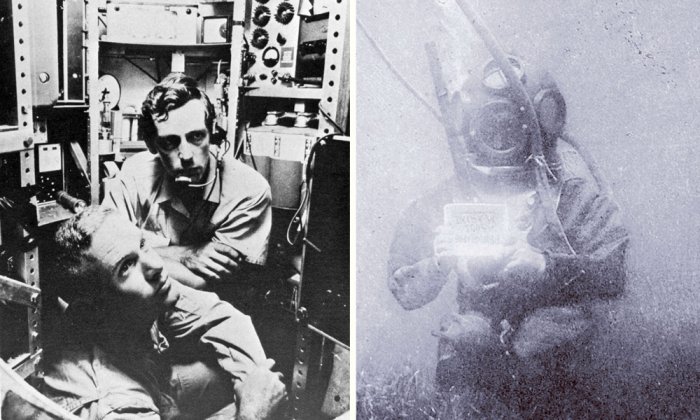
What might someone descending into the depths of the ocean hope to encounter? Undersea cities? Phosphorescent monsters? Aquatic mutants? Mislaid divinities? Sea cucumbers? Caverns leading underneath the earth’s crust? Wrecked liners and battleships? The souls of the drowned? Barren waters? Eternal darkness?
“In the Abyss” (1896), by H.G. Wells, tells of a metal sphere that takes a single voyager down into the Atlantic, where he discovers a city occupied by aquatic humanoids. The creatures treat him as a divine being and attach his sphere to an altar. The voyager resurfaces to tell his tale, only then to re-submerge. He is never seen again, presumably preferring a short period of worship undersea to a banal life on land. The Wells sphere is inventive, a foretaste of things to come, even if it includes an unlikely clockwork release mechanism that enables its return to the surface. Jules Verne, speaking from a position of superiority as the older and more experienced writer, but also aware that his work was becoming dated, noted that Wells’ stories lacked a solid scientific basis:
I consider H G Wells as a purely imaginative writer … I have always made a point in my romances of basing my so-called inventions upon a groundwork of actual fact, and of using in their construction methods and materials which are not entirely beyond the pale of contemporary engineering skill and knowledge … The creations of Mr Wells, on the other hand, belong unreservedly to an age and degree of scientific knowledge far removed from the present, though I will not say entirely beyond the limits of the possible.
Wells countered that in a work of fiction imagination was required to interpret the advances of science. This struggle between rampant imagination and scientific fact was to continue into actual undersea exploration — the two are always inextricably entwined.
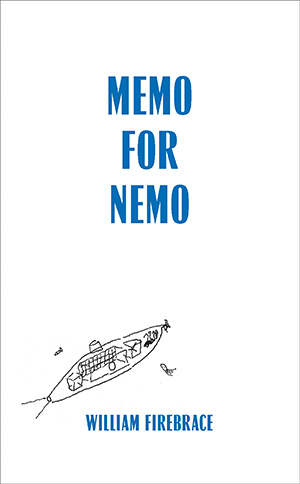
Many undersea tales feed on traditional ideas of legendary lost civilizations such as Atlantis, Lemuria and Mu, but updated to reflect contemporary concerns. Most settle for just enough technological know-how to get the cast of characters to the sea floor; they are more interested in the underwater societies than the vessel used to reach them. “The Scarlet Empire” (1906), by the American industrialist David Maclean Parry, neatly avoids any technological complications. His protagonist — a suicidal socialist worker — jumps off a Coney Island pier and sinks to the seabed, where he finds himself in a dystopian society, a vast city enclosed by a futuristic undersea dome, run along pseudo-socialist lines. All citizens are equal, all work shared, everybody wears the same style of red-colored clothing, with a nightmare bureaucracy of inspectors and informants — and even a kraken that devours the dissidents. Later descents into the depths offer their own versions of societies on the ocean floor. In Arthur Conan Doyle’s “The Maracot Deep” (1929) a group of adventurers, including an Aronnax-like professor Maracot, author of “Pseudo-Coralline Formations and the Morphology of Lemmelibranches,” explore the waters off the coast of Africa in a cube-shaped vessel equipped with all modern comforts. As they descend they make observations not far off those made by the naturalist William Beebe a few years later:
light green water turned to dark olive, that again deepened into a wonderful blue, a deep rich blue thickening to a dusky purple.
On the ocean floor they find an Atlantean civilization based on slave labor. A struggle between good and evil ensues, with predictable results, and the voyagers return to the surface.
Dennis Wheatley, purveyor of tales of erotic Satanism set among the British upper class, followed with “They Found Atlantis” (1936), written just after Beebe’s actual 923-meter bathysphere descent off the coast of Bermuda. Here, another group of adventurers are sent down in another metal sphere to find “the original garden of Eden as far as the white races go” — a place that turns out to be the scene of a constant battle waged between the idealized white humans and the sub-human captives, who live in tunnels.
A vessel for humans to descend into the abyss can only use one form, the sphere, which provides equal resistance across its continuous surface.
These stories use imagined aquatic civilizations to reflect on actual societies on land, mirroring aspects of the thinking of the times. Conan Doyle describes a spiritual confrontation with a supernatural being; Parry gives us a skit on early socialism, Wheatley a perfect white race whose symbol is the swastika, engaged in a program of exterminating the racially “degenerate” — a disturbing forecast of what would soon happen in central Europe. The lack of knowledge about the nature of the undersea allows the ocean floor to be used as a fictive location where another kind of society can thrive, not so far away from life on land. Most of the architecture in these tales is not particularly inventive, though Parry is bold enough to propose enclosing the city within a dome, while Conan Doyle powers his metropolis with energy taken from beneath the earth’s crust — both visionary ideas which reappear in later iterations of undersea worlds. A constant leitmotif is the fragile encounter between the people of the land and those of the sea, which usually spells disaster for the latter, their civilization destroyed as the waters rush in.
Actual descents run alongside fictional ones. They may discover less on the ocean floor — as yet, no underwater civilizations have been revealed — but their technology, and also the psychology of those making the voyage, is rather more interesting. Undersea vessels from which the crew can actually see, and which are intended to dive deep to observe and record the environment, are very different in design to windowless submarines, which stay in the upper reaches of the sea. Verne’s Nautilus, with its large internal spaces, would have been unable to descend much further than a couple of dozen meters before its windows caved in. In fact, the spherical shape Wells envisioned for deep-sea voyages turned out to be closer to reality. The construction of any deep-sea vessel is determined by its ability to withstand water pressure, which increases by one atmosphere (kPa) for every 10 meters of depth — and thus at 1,000 meters is already 100 times greater than at the surface. A vessel for humans to descend into the abyss can therefore only use one form, the sphere, which provides equal resistance across its continuous surface. Any other form would be crushed under the effect of the extreme pressure working unevenly on its more complex surfaces. Effectively a bubble of air, the sphere can contain a small living space for the crew. It has to be able to move vertically to descend and, more importantly, ascend back to the fresh air at the surface. It can do this either by hanging from a cable attached to a surface vessel, a method used in earlier devices such as the bathysphere or, more ingeniously, by altering its buoyancy so that its density changes and it can control its own vertical movement, as with the bathyscaphe (bathys — Greek for deep).
In the absence of any obvious military or commercial use the invention of deep-sea vessels has always relied on a certain amateur spirit. Often designed, built and operated by the same person, these vessels are devised with great ingenuity, but also tend to teeter on the fine line between success and failure. Their history, which sometimes edges into those fictional descents, extends much further back than Wells’ story. The Catalan inventor, Cervo, descended into the Bay of Barcelona in 1831 in a homemade wooden sphere with a single porthole, but failed to return. In 1865 Ernest Bazin, from Angers, rigged a wooden turret with an electric lighting system of his own invention, descending to 28 meters to observe fish at night. In both instances the vessels were lowered by cable from a surface ship. In 1889 the Italian engineer Balsamello demonstrated in the waters of Civitavecchia a metal sphere capable of moving both vertically, altering its buoyancy by using external weights which could be jettisoned for ascent, and horizontally, via hand-operated propellers. Nine years later, Count Piatti dal Pozzo constructed an extraordinary steel sphere, with room for three passengers, an extendable arm for seizing underwater objects, and a telephone connection to the surface. Once again lowered on a chain, it descended 50 meters off Cherbourg.
The bathysphere, the first vessel that could effectively descend into the depths, came out of a working partnership between the engineer Otis Barton and the noted American naturalist William Beebe. A precise observer of the natural world, Beebe was also a restless adventurer who wanted to go beyond the accepted boundaries of research. He began his career studying birds, going on long expeditions to tropical locations, but then became increasingly fascinated by the fish in the clear waters around the Galápagos Islands, Haiti and finally Bermuda where, in the late 1920s and early 1930s, he began making dives to observe undersea life. Like Boutan earlier in the century, however, he realized that what he was seeing was a minute proportion of the undersea environment, and set out to construct a new version of the diving bells in order to reach greater depths. Barton, a rich engineer, read about his exploits and proposed his own spherical design, which Beebe promptly approved. While Beebe’s aim was to go undersea to observe and record following the careful tradition of the scientist, Barton used his engineering knowledge to devise the technology for the metal sphere, and also provided the finance to construct it.
Barton’s vessel, 1.5 meters in diameter, was constructed of two cast-iron hemispheres welded together. Slightly heavier than water, but without the ability to adjust its buoyancy, it was designed to be suspended from a steel cable gradually let out from a winch on a surface vessel. The occupants wriggled in through a small round hatch, whose bolts were turned with a sledgehammer. Once inside the minimal space, they had to kneel on the floor, the equipment leaving no room for the luxury of seats. In the place of the grand windows of the Nautilus salon, with their expansive views of the undersea and its creatures, there were now two small ports of fused quartz through which it was just possible to peer out into the underwater world. The bathysphere had the form of a detached eyeball, freed from any accompanying body, sinking down into the ocean. Reduced to the most basic three-dimensional figure, suspended by a fragile cable in a dangerous environment no one had ever visited before, it barely supported the life of the occupants inside.
In 1930 the bathysphere descended off the coast of Bermuda to a depth of 434 meters, reaching 676 meters in 1932 and 923 meters in 1934. The swell of the sea combined with the sphere’s movement below the waves meant there was always a risk that the cable would snap, sending the sphere down to the seabed, where the occupants would either be crushed by the pressure or quickly run out of oxygen. Beebe wrote in his book, “Half Mile Down”:
I shall never experience such a feeling of isolation from the surface of the planet earth as when I first dangled in a hollow pea on a swaying cobweb half a mile below the deck of a ship rolling in mid-ocean.
As the bathysphere sank into the sea he described the gradual fading of colors:
- 383 foot: we are passing the deepest submarine record.
- 525 foot: a diver in an armored suit descended this far into a Bavarian lake — the deepest point a live human has ever reached.
- 600 foot: only dead men have descended deeper than this.
- 700 foot: we were the first living men to look out at the strange illumination. And it was stranger than any imagination could have conceived. It was of an inconceivable translucent blue quite unlike anything I have ever seen in the upper world and it excited our optic nerves in a most confusing manner, we kept thinking and calling it brilliant … I brought all logic to bear, I put out of mind the excitement of our position in watery space and tried to think sanely of comparative colors and I failed completely … the blueness of the blue both inside and outside our sphere seemed to pass materially through the eye into our very beings.
The existence of bioluminescence in the deep sea was already well known, as shown by the passage from “Twenty Thousand Leagues Under the Sea” where the submarine reaches the Indian Ocean and Aronnax observes:
The Nautilus was floating in a phosphorescent stratum, which was becoming dazzling in this darkness. It was produced by myriads of animalculae, whose brightness increased as they slid over the metal hull. I then noticed sparks in these luminous waters, as if produced by streams of molten lead in a fiery furnace … the light felt as if it were alive.
Such underwater glowing had been observed by both fishermen and scientists on the surface of various oceans, but its origins had never quite been explained. Beebe was the first person to see bioluminescent creatures in their actual environment:
Several times there were flashes of light from unknown organisms, so bright that my vision was confused for several seconds. Often the abundance of light was so great that the comparison is unavoidable with the stars on a clear moonless night.
To reinforce the parallel, his book has photographs of stars at night laid out on the same page as photographs of the deep sea:
The only other place comparable to these marvelous nether regions must surely be naked space itself, out far beyond atmosphere, between the stars, where sunlight has no grip upon the dust and rubbish of planetary air, where the blackness of space, the shining planets, comets, suns, and stars must really be closely akin to the world of life as it appears to the eyes of an awed human being in the open ocean a half-mile down.
The bathysphere was linked to the surface by a telephone line inside the support cable, which allowed Beebe to instantly communicate his observations to the crew above. He used these reports, rather than the notes written in the sphere, as the basis for his books. On one occasion the bathysphere even went live on U.S. radio, the little sphere in the depths of the ocean reporting to a large audience over the airwaves.
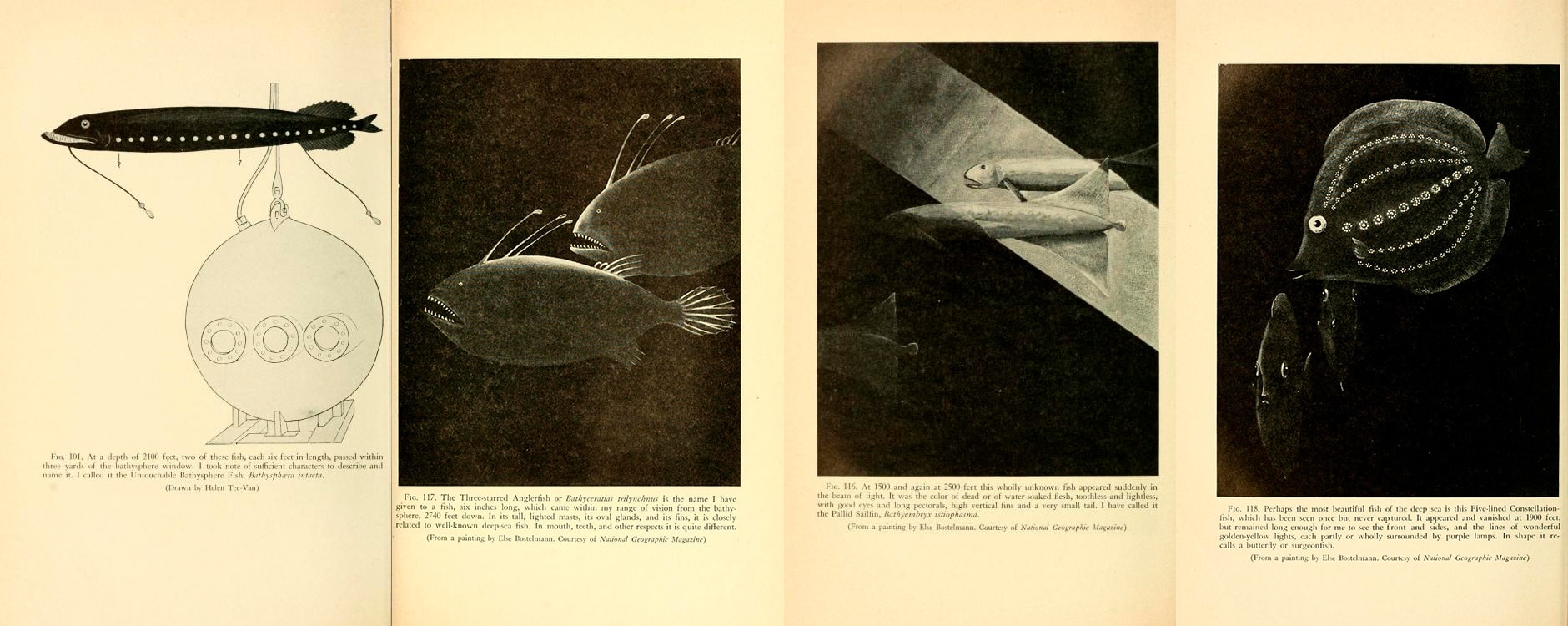
While Dr. William Beebe was seen as a distinguished man of science, his colleague Otis Barton was often dismissed as merely the pragmatic man who bankrolled the project and provided the expertise. But Barton wasn’t just an engineer — he was also a man with a sense of drama. He wanted to invent and design a device that would make him famous and bring him into contact with an exotic world, less like the sea he and Beebe had documented and more like something out of an undersea drama by Méliès or Williamson. Barton had been greatly impressed by various early undersea films, including Williamson’s work on “Twenty Thousand Leagues Under the Sea,” and wanted to make a film using the actual undersea as the setting for fictional adventures. Unfortunately he was unable to use any of the footage from the bathysphere as everything he filmed came out black or blurred. Realizing that a story about scientists looking at fish was unlikely to draw a crowd, he hired a variety of diving girls in bikinis who brandished spears in make-believe battles with artificial sharks and rays. A poster for Barton’s film — eventually released in 1938 as “Titans of the Deep” — shows women grappling with undersea monsters while the intrepid engineer looks on through one of the windows of the bathysphere, finding a new use for the device as the hiding place of the sub-aquatic voyeur, the descendant of the sailor in Méliès’ undersea romp.
In Verne’s time, underwater science and fantasy could sit happily together, undisturbed by erotic activities, but now they needed to be clearly separated. Barton’s film was a box-office flop, and prompted a split from Beebe, who found it demeaning to his reputation as a man of pure sciece — a reputation already tarnished by allegations that the voyages in the bathysphere had impaired his critical faculties, leading him to invent fantasy sea creatures. Beebe complained that Barton saw nothing of the undersea because he was always trying to look through his camera. Barton in turn felt that Beebe saw only fish and missed the true adventure. Beebe would eventually lose interest in the deep sea and return to the study of tropical wildlife — and a series of divorces much discussed in the gossip magazines. Barton, however, continued with his aquatic exploits, evolving his bathysphere with a strengthened hull for deeper dives and renaming it the benthoscope. In 1949 he descended alone, off the coast of California, unencumbered by the distraction of studying fish with Beebe, and reached 1,370 meters — a depth no one had ever reached before. At this depth the light failed and his telephone communication to the surface was broken. For a period he was left completely alone. Confident of his rescue, and thinking always as a filmmaker rather than as a marine biologist, he reached for his camera — only the thought that its flash might set off a fire made him reconsider and wait to be hauled back up.
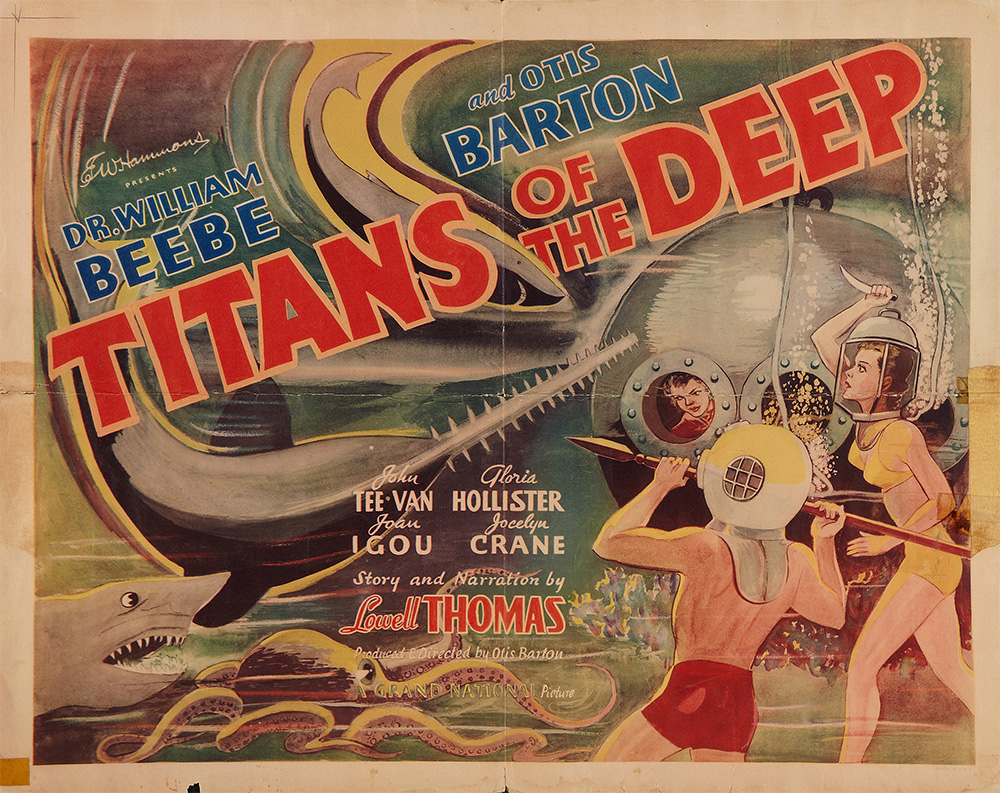
In everything he undertook Barton was an adventurer-engineer, an enthusiast for establishing records. His sphere appeared in Popular Mechanics in 1931 under the title “Three Hundred Fathoms Beneath the Sea,” though the article was more about Beebe and exotic fish than Barton, who is only mentioned as Beebe’s assistant. Unfazed, Barton designed the tractor-sphere, a version of the bathysphere mounted on caterpillar tracks, the first deep-sea vehicle. An illustration of it is shown on a 1935 cover of Modern Mechanix and Inventions, colored bright red and with three round searchlights on the roof, like a sports car for teletubbies, motoring along the ocean floor with Barton in the driving seat. The tractor-sphere was unfortunately never constructed. Later, Barton became interested in aeronautics, inventing a “spacecraft of the jungle” — a balloon for exploring the rainforest canopy. His autobiography is simply titled “Adventure on Land and Under the Sea.” This do-it-yourself attitude, originating perhaps with Nemo as designer, builder and commander of his own submarine, maintained a tradition of engaged amateurism in undersea exploration. It was also around this time that Jacques Cousteau began his career as an amateur diver, experimenting with homemade equipment and improving the aqualung with the help of an automotive engineer, using car parts for the air regulators.
The bathysphere is the simplest of platonic forms, confined to an up-and-down movement. Chosen by Barton for its ability to resist pressure, the sphere also presumes a kind of ideal subaquatic geometry, making for the most elementary of undersea architecture. The sphere is the perfect enclosing space, without angles or sides, a continuous external and internal surface, almost womb-like. Spherical buildings have been proposed on land, such as Étienne-Louis Boullée’s grandiose cenotaph for Isaac Newton, and they feature occasionally in idealized architectural proposals, but the sphere is not particularly suited to land-based constructions, given its tendency to roll around. In the sea, by contrast, it is in its natural element. Images of humans living in the minimal and ideal space of the sphere surface at various times in unexpected aquatic locations. Hieronymus Bosch’s painting “The Garden of Earthly Delights” shows many spheres of many sizes, including a vast transparent sphere enclosing the flat disc of the Ptolemaic world floating on a primeval ocean. There is a detail of two spheres floating on water, one above the other, which make up a strange plant — the upper, transparent sphere contains a naked couple, while the lower one is colored pink and solid, with a man peering out through a viewing tube. Both are about the size of the bathysphere and appear as if they are about to sink into the surrounding waters to embark on some medieval voyage of discovery. Just what they mean depends on the interpretation of Bosch’s bizarre view of the cosmos, but the upper sphere is a minimal sexual space, containing and nurturing the two lovers, while the lower sphere is a device for observing the natural world, corresponding to the small viewing ports of the bathysphere. The idea of a sphere that is transparent, as opposed to the opaque sphere of Barton, transforms the vessel. From being a viewing device where the interior is concealed, it becomes an object of display, a kind of reverse goldfish bowl where the occupants are visible to those in the water.
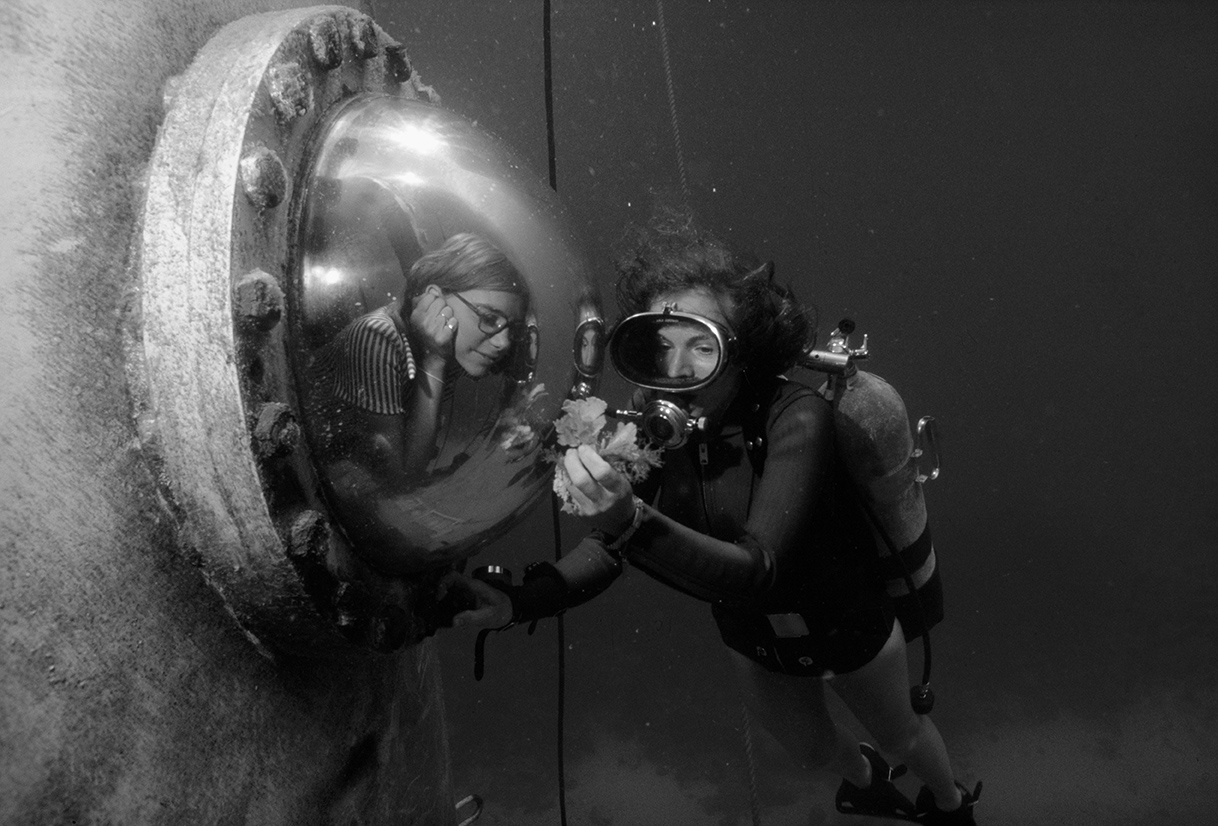
The transparent sphere of Bosch would reappear the late 1980s, shorn of its obvious religious and sexual imagery, in the form of vessels like the Deep Rover, a polycarbonate bubble capable of descending to 900 meters, manned by the husband-and-wife team of Graham Hawkes and Sylvia Earle. Since then there have been various undersea vehicles with polycarbonate spheres allowing an almost 360-degree field for the occupants, as well as a view into the interior from outside. The old relationship of the Nautilus window to the sea, with the observers hidden and peering out, has been subverted; in these transparent spheres it is no longer clear just who is the observer, and who the observed.
The bathysphere is more profound than just an ingenious vehicle. The quality that makes it most unusual is precisely what makes it attractive to those seeking extreme solitude.
However, something is missing from these later vessels, their openness to the world giving the feel of being the undersea equivalent of sports cars. The bathysphere is more profound than just an ingenious vehicle. The quality that makes it most unusual — the sense of being in a minute enclosed space in the vast volumes of the ocean, entirely cut off from the known world — is precisely what makes it attractive to those seeking extreme solitude. Is there any habitable space more extreme than the bathysphere? Where would be a more appropriate location for those wishing to get as far away as possible from the everyday world? In “The Bathysphere” (2009), the poet Don Paterson acquires a bathysphere by error at an auction and sits in it for no particular purpose:
What did I want with it? God only knows
there were days when I wondered, sat bored to tears
with my legs asleep, with my hands on the dead levers
and barely light to read the empty log,
but something—it was maybe just the cost—
had me stay on, and so I kept my station
till such goose-cries or gear-grinds as could reach me
came slowed and lowered as through a dream of water.
Paterson’s bathysphere, brought up onto land, seems to ascend or descend without command, almost at random. The occupant is on his own, but there appears to be some kind of living beings on the outside, which brings a certain happiness. In the last line of the poem the vessel goes on rising, as though transformed from oceanic bathysphere to aeronautic balloon.
so the whole world blooms continually
within its true and hidden element
a sea, a beautiful and lucid sea
through which it pilots, rising without end.
In everyday language the idea of descent and ascent is loaded with acquired associations. Going down is traditionally a phrase for matters getting worse, going up implies getting better. An upper raises the spirits. A downer is a bad trip, reaching the bottom implies things are as bad as they can be. Going down into the depths of the oceans has a scary and disturbing aspect, not just because of the physical location, but also because of the cultural and psychological associations of descending into a deep dark place. Going deeper also means becoming less superficial, reaching a more profound spiritual and intellectual state. The natural tendency of a human body is to float. Going down takes physical effort. “Just as one’s body has a natural tendency to surface and has to make an exertion to get towards the bottom — so it is with thinking,” Ludwig Wittgenstein wrote of swimming. If only philosophical investigations were as simple as diving.
The notion of isolation in a small sphere in the depths of the ocean is at once intensely worrying and subtly attractive. The American singer-songwriter Bill Callahan’s song “Bathysphere,” performed with spooky aquatic guitar sounds, describes the vessel as the location for complete isolation and deep dreaming. The lyrics have a heavy, slow feel:
When I was seven
I asked my mother
to trip me to the bay
And put me on a ship
And lower me down
And lower me out of here
Because when I was seven
I wanted to live in a bathysphere.
The chorus of “Ah ah ah” seems to gasp for air. The bathysphere is the ideal escape location, particularly for an introverted child.
In a bathysphere one does not have to face the difficulties of life on the surface. There is a contradiction between the occupant feeling relieved and therefore light, but also moody and heavy. The idea of the bathysphere cable breaking seems a kind of relief, a move towards personal freedom: separated from its link to the surface, the bathysphere will take the occupant to a new life, a distant memory perhaps of Nemo’s desire to escape the surface for the limitless and uncontrolled realm of the undersea.
Separated from its link to the surface, the bathysphere will take the occupant to a new life, a distant memory perhaps of Nemo’s desire to escape the surface for the limitless and uncontrolled realm of the undersea.
In its own way Barton’s sphere also migrated upwards, away from the force of gravity, to outer space. Yuri Gagarin’s space capsule for his orbit of the earth in 1961 was another sphere, just large enough to contain a human being — a bathysphere in reverse — going up rather than down. In Stanley Kubrick’s “2001: A Space Odyssey” (1968) a spherical capsule is used to transport the astronaut Dave Bowman through the rings of Jupiter, through a cosmological light-show not dissimilar to the one Beebe describes undersea, before ending up in a bedroom decorated in a corporate version of classical style — perhaps a 21st-century equivalent of the Second Empire rooms of the Nautilus. Just as “2001” seems to imply that the journey to the outer reaches of space is also a personal existential journey, so Beebe described his descent in terms of a journey into inner space, traveling deep down not only into the sea but also into the self: The bathysphere was “a temporary universe, like Einstein’s a curved one, with a vengeance.” Once again, we could be in some piece of sub-aquatic Samuel Beckett theatre, a space from “Imagination Dead Imagine” perhaps, with two bodies pressed within a small hemisphere rather than a sphere:
No trace anywhere of life, you say, pah, no difficulty there, imagination not dead yet, yes, dead, good, imagination dead imagine. Islands, waters, azure, verdure, one glimpse and vanished, endlessly, omit … Emptiness, silence, heat, whiteness, wait, the light goes down, all grows dark together, ground, wall, vault, bodies, say twenty seconds, all the greys, the light goes out, all vanishes. At the same time the temperature goes down, to reach its minimum, say freezing-point, at the same instant that the black is reached, which may seem strange.
From these wanderings of the extreme space of the Barton sphere, into outer space and into the depths of the soul, one returns to the undersea, and the design of vessels that really could go down into the abyss. The diving depth of the bathysphere was restricted by the length and strength of its supporting cable. In order to go deeper, a more sophisticated system was required. The bathyscaphe — invented by the Swiss engineer Auguste Piccard during the late 1930s, but not constructed until the late 1940s due to the caesura of the Second World War — was an immaculately considered device: an undersea elevator, capable of rising and falling at considerable speed but with little potential for horizontal movement. In appearance Piccard was every inch the classic eccentric boffin: very thin with large glasses and waves of white hair. After spotting him on the street in Brussels, the cartoonist Hergé made him the model for the deranged inventor, Professor Calculus, in “The Adventures of Tintin.” In one photograph Piccard is seen drawing the bathyscaphe on a blackboard using both hands, a piece of chalk in each, as though both sides of his brain — the pragmatic and the fantasist, or perhaps the inventor and the adventurer — needed to express themselves simultaneously. Dressed in a similar shirt with a high white collar and lab coat, Calculus designs the impractical shark-like submersible used in “Red Rackham’s Treasure,” published in 1944.
Piccard’s scientific enquiry was originally focused on going up rather than down. To investigate cosmic rays he invented a balloon of extreme lightness with a spherical aluminium cabin, which he named the FNRS-1, after the Fonds National de la Recherche Scientifique, the research society funding the project. The FRNS-1 resembled the eye-balloon in Odilon Redon’s 1878 engraving “L’oeil, comme un ballon bizarre se dirige vers l’infini” (The Eye Like a Strange Balloon Mounts Towards Infinity), in which a large, floating eye, surmounted by a hairy fringe, stares ever upwards into space while carrying a hat with a face embedded in its crown. In 1932 Piccard’s investigation took him on a 16,201-meter ascent. He was the first man to look out onto the pure light of the stratosphere, unaltered by the effects of the atmosphere.
The basis of Piccard’s bathysphere was to create a vessel like an aeronautic balloon but capable of operating underwater. His first bathyscaphe was the FNRS-2, its voyage down complementing the upward movement of the earlier FNRS-1 balloon. There are two parts to the Piccard bathyscaphe: the buoyancy tank, which controls movement up and down, and a spherical container for the crew, much like the one Barton designed. The vessel is slightly confusing to understand from pictures, since what looks like a submarine is actually only the buoyancy tank, and the sphere, the only part occupied by the crew, is almost hidden beneath its belly.
Piccard’s first bathyscaphe did well in early trials, and he made a short descent in the Mediterranean with the scientist Théodore Monod — another engineer-scientist pair. Monod wrote in his book on the undersea, “Bathyfolages” (1954), that “Two things used to leave Kant awestruck: the starry sky above and the moral law within man’s heart. Had our philosopher taken a dive in the bathyscaphe he no doubt would have added a third ‘wonder of the world’ to his short list: the fairy-like ballet of bioluminescent sparks that dot the abysmal night.” The stars and lights undersea are again compared, with the human heart to complete the triangle. When the bathyscaphe was taken to the coast of Dakar for a deep-water trial in 1948, however, its float was badly damaged in a storm, and it had to be scrapped. Work immediately began on a second bathyscaphe, the FNRS-3, of a similar design, reusing the sphere of the original vessel. At some point Piccard fell out with the French government, and so began work on his own bathyscaphe, constructed in Italy, the Trieste.
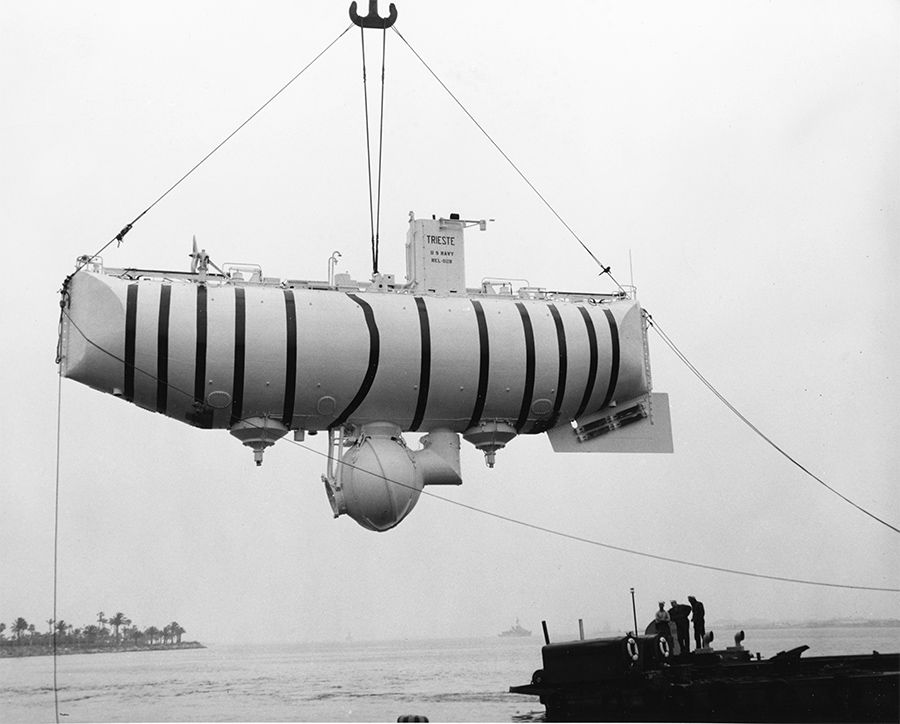
By the mid-1950s there were actually two bathyscaphes under construction, competing in a kind of subaquatic race to be the first to attain the greatest depth. Piccard’s rival, a French-Belgian vessel piloted by Georges Houot and the engineer Pierre Willm, was the first to get moving, going down to 4,050 meters off the coast of Dakar. However, only Piccard’s bathyscaphe was able to descend into the true abyss. In 1960 Trieste, piloted by the inventor’s son, Jacques, an engineer and marine scientist, and Don Walsh, a U.S. submarine commander — yet another variation on the team of two — descended to the deepest known point of the ocean: the 10,916 meters of the Challenger Deep at the southern end of the Mariana Trench in the Pacific Ocean. The descent was completed without any significant problems. The Trieste simply descended until it reached the ocean floor.
On the way down the two voyagers could see nothing; the bathyscaphe was traveling too fast to observe fish or other creatures. In any case there were only two points of importance: the surface and the ocean bed. Piccard and Walsh, squeezed together like Barton and Beebe in the sphere’s cramped interior, journeyed to the most isolated spot in all the oceans, in its own way a voyage as momentous as the one carried out nine years later in 1969, when Neil Armstrong and Buzz Aldrin landed on the moon. But the aquanauts were confined to their sphere, and upon arriving at their destination their only option was to turn around and begin a slow return to the surface under the terrible pressure of the water. The astronauts, on the other hand, released from the earth’s gravity, were able to bounce around the surface of the moon with a view of the vastness of the Milky Way, at the beginning of a series of journeys which could potentially extend to the furthest reaches of the universe.
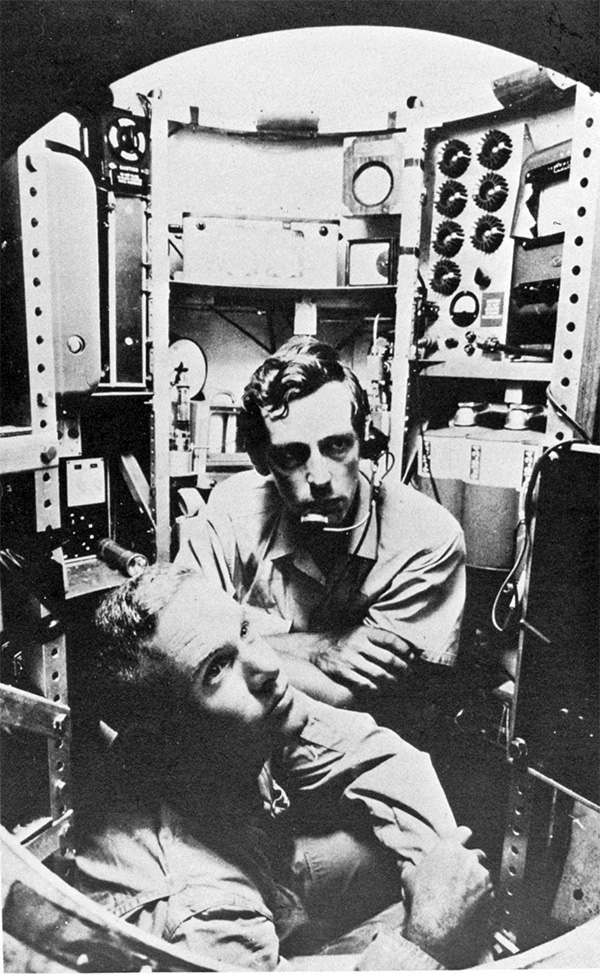
As aquatic eyes for observing hidden depths, bathyscaphes were not particularly effective. Early bathyscaphes simply ascended and descended, and were not particularly interested in any location between the surface and the depths. Their descent brought them down to a point which might be entirely untypical of the surrounding waters, just as an object descending at random from space to the surface of the earth might arrive in a desert or the middle of a city, and have no way of knowing whether this point was typical or exceptional. Trieste was equipped with a single viewing port made from dense perspex and illuminated by electric lights fixed to the sphere. As it landed on the bottom of the Pacific trench it sent up clouds of mud, making it difficult to see anything at all. Despite this Piccard claimed to have seen a small flat fish with eyes pointing upwards lying on the ocean floor. It seemed that even at this ultimate depth, in total darkness, creatures existed and were still equipped with eyes — a claim that was disputed by marine biologists who maintained that no creature could survive so far down. The photographs taken by Piccard were inexplicably mislaid. Apart from this dubious fish there was nothing else to observe — the deepest point in the ocean, one of the lines along which the slow geological movement of the tectonic plates takes place, appeared simply as a surface of ooze. Only later, on visits by unmanned vehicles, was it discovered that food drifting in the ocean gets trapped in these trenches, allowing an abundant ecosystem to flourish at the greatest depths.
For deep-sea vessels such as the Trieste, everything is based on an understanding of buoyancy, the theory of which begins, conveniently, in the domestic bath. Lying in his tub the ancient Greek polymath Archimedes realized that the more he sank down, the more the water overflowed — the volume of liquid displaced matching the volume of his body. Eureka! Archimedes wrote two treatises: “On Floating Bodies,” and the now long-lost “On Sphere-Making.” Together these would have defined some principles on underwater spheres. Any number of sea creatures have sac-like bodies whose density can be altered to control their vertical position in the ocean. Artificial vessels follow a simplified system, crude compared to the complex chemical and physical anatomies of marine organisms. Piccard’s bathyscaphe worked by filling a large buoyancy tank with gasoline, which, being lighter than water, caused the vessel to float — but only just. Metal weights attached to the underside of the bathyscaphe acted as ballast, causing the whole vessel, now heavier than the water, to descend. When the time came to ascend the weights were released, allowing the gasoline-filled buoyancy tanks to carry the vessel upwards, much as a hot air balloon lifts up a basket of passengers. As in a balloon, the material of the buoyancy tank can be very thin. Its internal pressure is always the same as the water outside, so in contrast to the sphere, which is filled with air, it does not matter how deep the float goes, its form will always remain the same.
There are of course various complicating factors. For vessels descending into the abyss, the external pressure changes according to depth, while the density of seawater varies according to location and depth, depending on factors such as temperature, salinity and quantity of microorganisms. At a depth which varies but is usually about 200 meters down there exists a zone known as the thermocline, where the water suddenly gets colder and the float of the bathyscaphe must increase in density to push its way through. Bathyscaphes appear as clumsy, lumbering vessels, but in the darkness of the undersea beauty and elegance do not depend so much on appearance. Seeing is of minimal importance — it does not really matter what things look like. The undersea has its own non-visual beauty, and many sea creatures appear ugly or incomprehensible if brought onto land. Buoyancy, then, is not just a pragmatic issue, but also describes a certain elegance created by the relationship between a creature or vessel and its environment. There is true beauty in the delicacy of these systems of balance and equilibrium, in the constant, minute adjustments made in response to small differences in the external environment. The writings of bathyscaphe pilots, such as “Seven Miles Down” by Piccard’s son Jacques, or the rival “Two Thousand Fathoms Down” by the French naval officer Georges Houot (competitive increases in depth are a feature of these book titles), detail the constant small adjustments to the ballast or gasoline that keep the bathyscaphe moving in the desired direction. Sometimes these adjustments really are minute: Houot records asking a sailor to stand on the deck of the FNRS-3 to help the vessel descend beneath the surface — a latter-day demonstration of Archimedes bathtub experience.
Stories of early descents to the ocean floor often tip into fiction.
There is one photograph that visually captures the delicate buoyancy of the bathyscaphe. In “To Hidden Depths” (1954), by the French diver Philippe Tailliez, the FNRS-3 is just below the surface, a mechanical creature with its stubby nose, rotund form and what appear to be fins. A diver equipped with an aqualung treads water just above it, perhaps checking on its descent. Bubbles drift up from his mask and the vessel. Somewhere below, just out of frame, is the sphere for the crew. The diver can’t go much deeper, yet the vessel is about to descend to the seabed several thousand meters below. Physics separates the diver, so fragile and exposed, from the swollen form of the vessel waiting just below the surface, and from the crew, isolated in their metal sphere.
Stories of early descents to the ocean floor often tip into fiction. Without any witnesses or technical records, a descent by one man is difficult to prove. Aside from the descent by Beebe and Barton in 1933, Barton’s own voyage in 1949, and the FRNS-3 manned by Georges Houot and Pierre Willm in 1954, there is talk of only one other descent, which took place in 1947 — though we have no evidence for it apart from the first-person account of a prisoner-of-war in a Russian labor camp in the far north of Europe. There are no photographs of this vessel, no witnesses, and it can be found in no museum. Its story, however, is related in detail by Philippe Tailliez in his book “Aquarius” (1961). Together with Jacques Cousteau and Frédéric Dumas, Tailliez had formed the pioneering 1940s French aqualung group known as les trois mousquemers — a phonetic play on Alexandre Dumas’ famous trio of mousquetaires — hinting at the sense of dashing adventure associated with early undersea exploration. He was also director of the French Group of Underwater Research and in the early 1950s helped Jacques Piccard take the bathyscaphe on its first outings off the coast of Dakar. Tailliez was Commander of the North Rhine Flotilla in the mid-1950s when by chance he came across a newspaper article that mentioned Heinz Sellner, a German engineer looking for funds to construct a deep-sea vessel. Sellner happened to live in a village that Tailliez used to drive through on the way to the naval base. Tailliez spoke little German, Sellner little French, but in 1957 they met and began to communicate through an interpreter. The engineer and his family were struggling to survive. He had sold off his house to pay his debts, and was working as a truck driver.
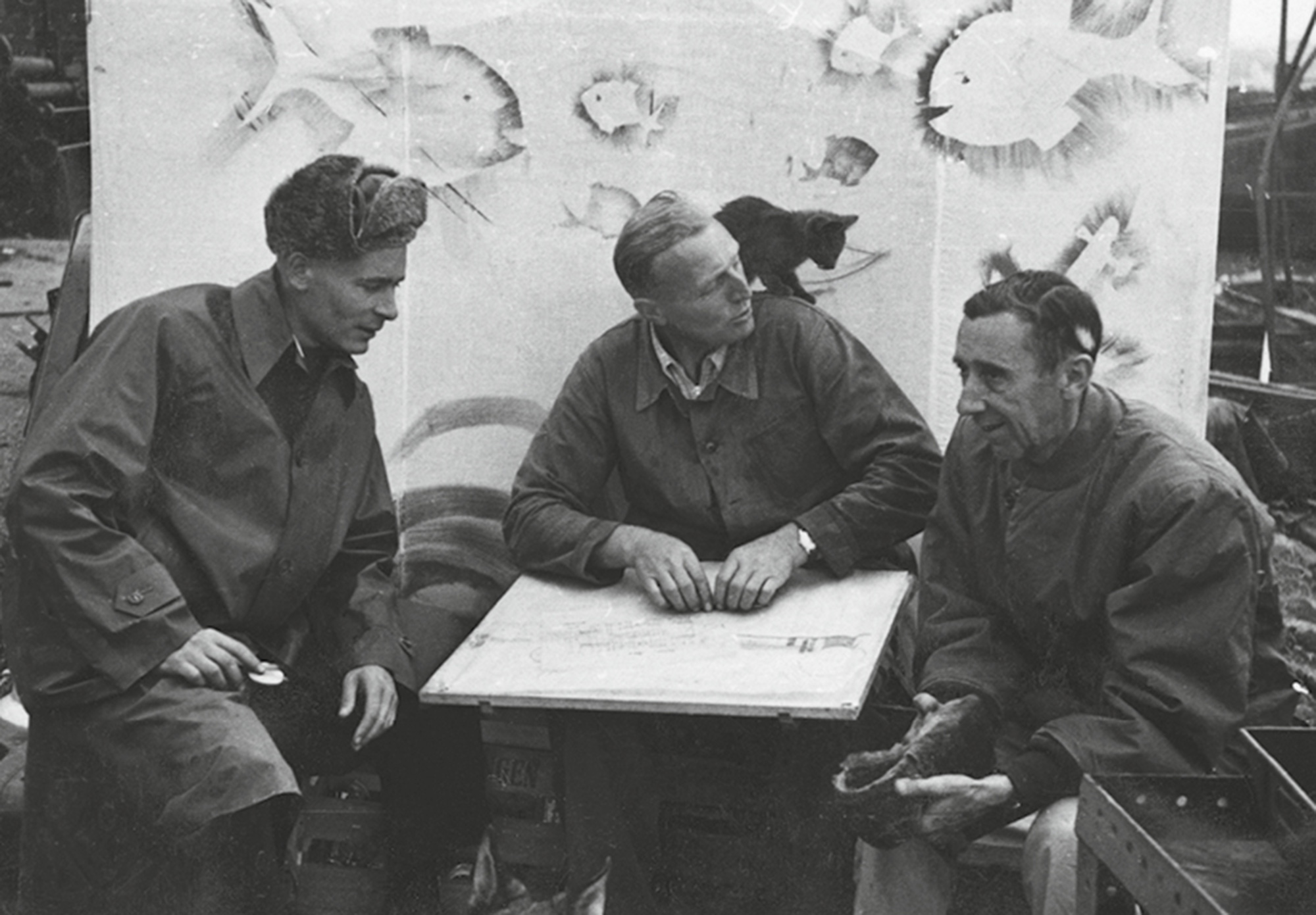
The son of a German naval engineer, Sellner had spent his childhood making mechanical devices out of scrap found in his father’s workshop. Toward the end of the Second World War he was captured by the Czechs, transferred to the Soviets and in 1946 was sent to a camp in the port of Murmansk on the Arctic Sea, where prisoners-of-war were set to work clearing the harbor and the neighboring Tuloma River of the many ships sunk by German air raids. The port had also become a storage zone for large quantities of captured German military equipment — trucks, submarines, engines, diving equipment, medical supplies and various naval objects of indeterminate, now-forgotten purpose. Sellner was appointed one of the camp’s chief engineers, responsible for repairing the equipment needed to raise the wrecks. This allowed him to simultaneously pursue a dream he had first had as young man: to devise a submersible which would rise and fall according to a system he had already invented using the liquefaction of air. In its gaseous state, air is diffuse and light, but when liquefied — as in a refrigeration system — it becomes comparatively compact and heavy. The change from one state to another creates the potential for a buoyancy device, first heavier then lighter than water. The need for a large buoyancy tank was similar to Piccard’s system, but Sellner’s worked more like a submarine, varying buoyancy without the use of metal ballast and replacing the compressed air system with a liquefaction system. At the surface, the buoyancy tank is filled with both seawater and air, the proportions of which are controlled so that the vessel just floats. The air is then cooled and liquefied, significantly reducing in volume and allowing more water in through an opening at the bottom, making the tank heavier and causing the vessel to descend. When the pilot wishes to ascend, the process is simply reversed: the liquefied air is evaporated and expands, pushing the seawater out of the tank, and the vessel, now lighter than water, moves upward. Sellner’s system has two advantages: no air is lost, since it is simply liquefied and then vaporized and, more importantly, the extreme change in air density gives the vessel much more lifting power than simply blowing out the buoyancy tanks with compressed air.
The Soviet supervisors, suitably bribed with vodka, agreed to support the construction of a trial machine. If it turned out to be as buoyant as Sellner promised, it could indeed be used in salvaging ships sunk in the war, and so everybody stood to make a profit. Sellner’s real aim, however, which he concealed from everyone except a few trusted fellow prisoners, was to construct a primitive bathyscaphe capable of descending several hundred meters under the sea — a most unlikely ambition for a half-starved prisoner-of-war isolated above the Arctic Circle. Sellner must have known something of Barton’s bathysphere and of Piccard’s efforts in the late 1930s, but quite why he wished to go down into the deep, rather than simply devise a submersible for raising wrecks, he never explained. In the transcript of the recording made by Tailliez, Sellner talks in great detail about the technical issues, but rarely about his desires. “Life had,” he recounted, “no more meaning for me and no more value, apart from that absurd idea that I had the means to carry out.”
The Soviet supervisors, suitably bribed with vodka, agreed to support the construction of a trial machine. If it turned out to be as buoyant as Sellner promised, it could be used in salvaging ships sunk in the war.
Sellner selected an abandoned 30-meter-long U-boat hull as the buoyancy tank. He then converted this hull to use his gas liquefaction system, employing the internal compartments between the bulkheads as variable buoyancy chambers so that the hull could be made to descend and ascend underwater. Sellner also discovered among the military junk a metal sphere about 2 meters in diameter, possibly once a floating German observation post — another abandoned eye. This sphere was adapted and attached to the underside of the hull as a chamber for the proposed one-man crew — Sellner. Searchlights, batteries, hatches and so on were also all converted from available scrap. The whole vessel was constructed in different workshops within the camp so that no one except Sellner could understand the ultimate aim.
Some of the other German prisoners-of-war became concerned that Sellner would use his submarine to escape, and that they would be shot in retribution. Several times he had to swear he would not leave. Having convinced both his captors and his fellow prisoners that he would be helping to raise wrecks in the Bay of Kola, Sellner submerged his bathyscaphe to move out of the range of the camp, then surfaced and traveled several hundred miles from Murmansk using the propulsion system of the submarine, going around the top of Norway to a point west of Lapland where the Greenland Sea is at its deepest — a point just to the north of where the Nautilus disappears in the maelstrom at the end of “Twenty Thousand Leagues Under the Sea.” At this remote location he used his liquid gas system to descend to a depth of 2,400 meters (the sphere of Beebe and Barton, hanging from a cable, had reached just over 923 meters). Unlike Beebe, Sellner had no interest in actually discovering anything at the bottom of the sea — in the almost total darkness, there was nothing much to discover. He says in the recording, anticipating the statement of Piccard at the bottom of the Mariana Trench:
There was little to be seen through the porthole, the lights were functioning correctly but their effect was so slight that I could make out nothing clearly. In any case I was so busy controlling the descent and my machinery that I had no time to look out.
It is difficult to imagine what it would be like to be completely alone inside a small metal sphere in the cold darkness at the bottom of the Greenland Sea. Perhaps it was this search for an extreme isolation that inspired the voyage.
Sellner then re-vaporized his liquid gas in the U-boat hull and navigated back to the Bay of Kola, where he joined his comrades who were raising wrecks at a prearranged underwater location, before returning to Murmansk. He sank the metal sphere in the river and removed all the gas liquefaction equipment from the U-boat for fear of being discovered by the Soviets. Shortly after his voyage Sellner became severely ill and had the good luck to be repatriated to Germany. The other prisoners in the Murmansk camp, their work now complete, were sent east to Siberia and never made it back home.
Tailliez obtained funds for Sellner to build a second bathyscaphe in a workshop on an island in the Rhine because he believed his tale — he recognized in Sellner the quality of a man who worked with his hands to repair and construct mechanical devices, rather than fabricate stories. Working virtually alone, Sellner constructed this vessel on the same principles as the first, again using scrap materials leftover from the war. All this is documented by amateur photographs of Sellner, a big fair-haired man, usually smoking a cigarette, on the quayside beside the Rhine: Sellner bending hoops, Sellner and his cats, Sellner repairing an engine, Sellner working on what looks like an oversized boiler encircled by metal rings, Sellner sorting out cables. At least these photographs are some sort of evidence that Sellner existed and built a bathyscaphe. This new vessel — baptized Aquarius II, in retroactive recognition of the first, unnamed Murmansk bathyscaphe — was shipped in 1959 to Tailliez’s and Cousteau’s undersea research center in Marseille, where it was fitted with the complex electrics and pipework required for the vaporizers. However, on its first dive beside the Marseille quayside Aquarius II failed to function properly, listing badly and making descent impossible. Tailliez’s very limited funds had also run out. “I blamed myself,” he wrote, “for having blindly believed in the miracle of a homemade submarine. I blamed myself for chancing failure with makeshift accumulators. I blamed Sellner for having thought himself capable of carrying through a job that was beyond the strength of one man.” Aquarius II was lifted from the water and towed to the yards at Toulon, where some time later it was sold for scrap.
What is discovered deep undersea depends as much on human psychology as on reason and observation.
The bathyscaphe had failed, throwing doubt on the truth of the Murmansk story. Sellner lived for a few years more, building models of other bathyscaphes. He was last heard of in Marseille, working with Taillez, testing a model of a bathyscaphe to raise a model of Verne’s Nautilus. At this convenient point he disappears from the history of the undersea as mysteriously as he had arrived. Tailliez did wonder whether Sellner’s story was a hallucination, a false memory brought on by the chaos of war, the deprivations of the camp, the separation from home, the desire to escape to a location even more isolated but where everything was under his control. There is something of the Patterson poem in Sellner’s story, an attempt to escape from some unacceptable psychological state, something also of Nemo, fleeing the land for some better location undersea. Perhaps it does not matter whether Sellner’s story is true. It is the perfect undersea tale — an almost impossible voyage narrated in immaculate detail, fact built upon fact, but completely unverifiable.
After the success of Piccard’s Trieste, bathyscaphes developed into more compact machines, losing the great bulk of the buoyancy tank to become sophisticated undersea vessels. Whatever the nuances of the design, the tank is always a sphere which holds the crew. Submersibles such as the American Aluminaut and Alvin, the French Nautile, the two Russian Mirs and, more recently, the Japanese Shinkai and the Chinese Jiaolong, use stochastic foam, an ultra-lightweight artificial material, to supply negative ballast, rather than the great tank of petrol. Such vessels can move horizontally and are therefore more useful for research than earlier bathyscaphes. They are equipped with any amount of technology, lights, arms, scanners and cameras, able to record whatever they detect undersea, thus combining the filming function of Williamson’s photosphere with the deep-sea ability of Piccard’s bathysphere and the movement in three dimensions of ordinary submarines.
Only one other manned vehicle has returned to bottom of the Mariana Trench. The director James Cameron used the Deep Sea Challenger to descend into Challenger Deep in 2012. His vessel was of an entirely different level of technical complexity to the Trieste, constructed as a kind of deep-sea film studio, with a lighting tower of LEDs, cameras, grabs and vacuum pipes for sucking up samples. Cameron, who had already visited the depths of the sea for his films “Titanic” and “The Abyss,” descended in two hours to the deepest point in the oceans and filmed this normally totally dark zone, where the notion of the usual dimensions are brought into question, in 3D. It had taken 142 years since Nemo’s fictional photograph for anyone to return with a genuine image of the deepest point of the abyss.
Whereas even the scientifically minded Nemo discovers the ruins of the mythical sunken city of Atlantis, beside an undersea volcano, none of the actual voyages to the sea floor have uncovered any underwater civilization. There are no early socialist or racist societies living at these vast depths, no semi-humanoids, no Atlantean Satanists, no utopias, no dystopias. Instead, the principal inhabitants of the seabed appear to be slugs and sea cucumbers — although these are merely what we are capable of observing at present.
Other cultures may yet exist in the depths, so radically different from us as to be beyond our comprehension. Fiction films have continued to suggest what these other possibilities might be. Cameron’s “The Abyss” (1989) found divine beings, not so far off those imagined by Conan Doyle and Wells. The film “Sphere” (1989) naturally offered the ultimate undersea sphere, a vast construction from outer space that had found its way, by unknown means, onto the seabed. The film leaves open whether this grandiose sphere is imagined or actual, for what is discovered deep undersea depends as much on human psychology as on reason and observation. We do not always find what we expect, and we recognize only that which is within our own sphere of understanding.
William Firebrace is an architect and writer in London. He is the author of a trilogy of books: “Marseille Mix,” “Zickzack,” and “Memo for Nemo,” from which this article is excerpted.



